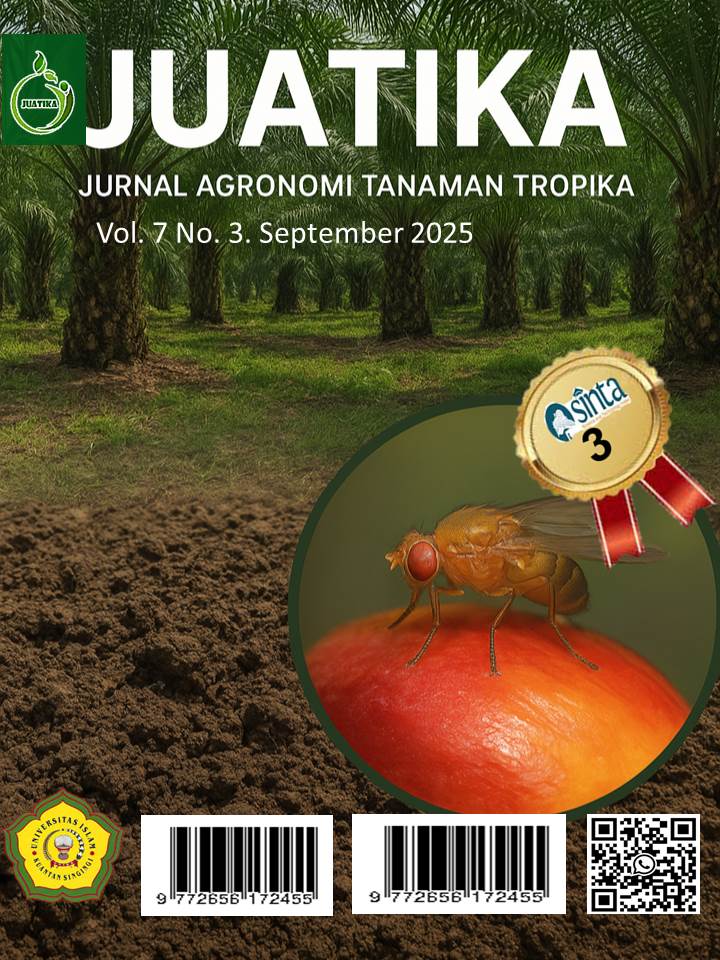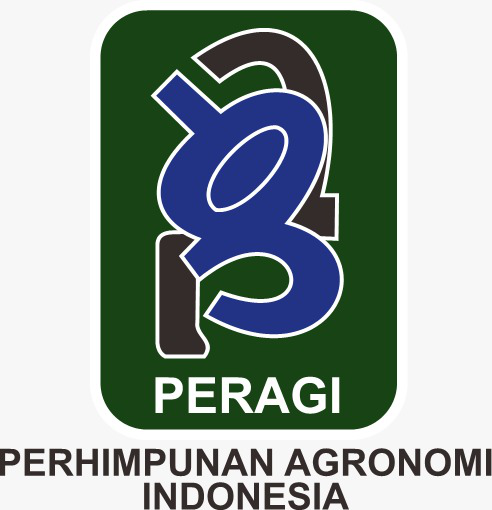Allelopathic Effects of Kyllinga brevifolia, Eleusine indica, and Sphagneticola trilobata on Lettuce (Lactuca sativa)
Abstract
Weeds are a significant constraint to crop production as they compete for vital resources and release allelochemicals that may hinder the growth of surrounding plants. This study investigated the allelopathic effects of plant litter from Kyllinga brevifolia, Eleusine indica, and Sphagneticola trilobata on the germination and early development of Lactuca sativa. Two bioassays were conducted: a sandwich method in the laboratory and a pot experiment in a greenhouse. Dried weed residues were applied at concentrations of 1%, 2%, 3%, and 4% to evaluate their impact on seed germination, root and shoot elongation, and biomass accumulation in lettuce. The results showed that all three species inhibited seed germination and seedling growth in a concentration-dependent manner. In the sandwich assay, germination rates at 4% residue concentration declined to 58.89% (K. brevifolia), 76.67% (E. indica), and 46.67% (S. trilobata), compared to 96.67% in the control. The strongest inhibition of radicle growth was observed in K. brevifolia (91.60%). In the pot experiment, both K. brevifolia and S. trilobata consistently reduced all measured growth parameters. At 4%, shoot length declined to 9.18 mm and 5.42 mm, and dry shoot weight decreased to 2.90 mg and 3.09 mg, respectively. In contrast, E. indica slightly increased shoot biomass at moderate concentrations, suggesting a potential stimulatory effect. These findings demonstrate that residues from these weeds possess strong allelopathic potential and could be explored as natural agents for environmentally friendly weed management.
Downloads
References
Ain, Q., Mushtaq, W., Shadab, M., & Siddiqui, M. B. (2023). Allelopathy: An alternative tool for sustainable agriculture. Physiology and Molecular Biology of Plants, 29(4), 495–511. https://doi.org/10.1007/s12298-023-01305-9
Alluri, G., & Saha, D. (2024). Emerging perspectives on non-chemical weed management tactics in container ornamental production in the United States. Horticulturae, 10(3). https://doi.org/10.3390/horticulturae10030281
Araújo, C. A., Morgado, C. S. A., Gomes, A. K. C., Gomes, A. C. C., & Simas, N. K. (2021). Asteraceae family: A review of its allelopathic potential and the case of Acmella oleracea and Sphagneticola trilobata. Rodriguesia, 72. https://doi.org/10.1590/2175-7860202172137
Arora, S., Husain, T., & Prasad, S. M. (2024). Allelochemicals as biocontrol agents: Promising aspects, challenges and opportunities. South African Journal of Botany, 166, 503–511. https://doi.org/10.1016/j.sajb.2024.01.029
Arroussi, J., Ouerfelli, M., Smaoui, A., Ahmed, H. Ben, Kaâb, S. Ben, & Kaâb, L. B. Ben. (2022). Antioxidant activity of seven plant extracts collected from Tunisia and their allelopathic potential on Lactuca sativa L. and Phalaris minor L. South African Journal of Botany, 148, 135–143. https://doi.org/10.1016/j.sajb.2022.04.029
Babu, M., Abirami, T., Velu, K., Janaki, A., & Fahd, A. (2025). Larvicidal activity and phytochemical composition of Kyllinga brevifolia (Poales: Cyperaceae) against mosquito vectors. Journal of the Kansas Entomological Society, 98(2), 62–74.
Bonanomi, G., Zotti, M., Idbella, M., Mazzoleni, S., & Abd-ElGawad, A. M. (2021). Microbiota modulation of allelopathy depends on litter chemistry: Mitigation or exacerbation? Science of the Total Environment, 776, 145942. https://doi.org/10.1016/j.scitotenv.2021.145942
Cheng, F., & Cheng, Z. (2015). Research progress on the use of plant allelopathy in agriculture and the physiological and ecological mechanisms of allelopathy. Frontiers in Plant Science, 6, 1020. https://doi.org/10.3389/fpls.2015.01020
El-Masry, R. R., Ahmed, S. A. A., El-Rokiek, K. G., Messiha, N. K., & Mohamed, S. A. (2019). Allelopathic activity of the leaf powder of Ficus nitida on the growth and yield of Vicia faba and associated weeds. Bulletin of the National Research Centre, 43, 1–7. https://doi.org/10.1186/s42269-019-0114-x
Fu, F., Luo, J., Zhao, L., Yang, F., & Wang, N. (2024). Impact of cellulose and lignin on restoration of vegetation and soil chemical properties for saline-alkali soil of Songnen Plain. PLoS ONE, 19(1), e0296366. https://doi.org/10.1371/journal.pone.0296366
Fujii, Y. (1990). Survey of Japanese weeds and crops for the detection of water-extractable allelopathic chemicals using Richards’ function fitted to lettuce germination test. Weed Research Japan, 35, 362–370.
Fujii, Y., Parvez, S. S., Parvez, M. M., Ohmae, Y., & Iida, O. (2003). Screening of 239 medicinal plant species for allelopathic activity using the sandwich method. Weed Biology and Management, 3(4), 233–241.
Handayani, A., Junaedi, D. I., & Zuhud, E. A. M. (2021). Ecological risk assessment of potentially invasive alien plant species in Cibodas Biosphere Reserve, West Java, Indonesia. IOP Conference Series: Earth and Environmental Science, 914(1), 012035. https://doi.org/10.1088/1755-1315/914/1/012035
Hussain, M. I., El-Sheikh, M. A., & Reigosa, M. J. (2020). Allelopathic potential of aqueous extract from Acacia melanoxylon R. Br. on Lactuca sativa. Plants, 9(9), 1228. https://doi.org/10.3390/plants9091228
Imad, M., Idrees, M., Hadi, F., Memon, N. H., & Zhang, Z. (2021). Allelopathic effect of Parthenium hysterophorus extract on seed germination and seedling growth of selected plants. Pakistan Journal of Botany, 53(6), 2187–2197. https://doi.org/10.30848/PJB2021-6(9)
Inderjit. (2001). Soil: Environmental effects on allelochemical activity. Agronomy Journal, 93(1), 79–84.
Ishak, M. S., Ain, M. N., Sahid, I., & Mardiana-Jansar, K. (2021). Allelopathic screening of Malaysian noxious weeds and several medicinal plants as potential alleloherbicides. Journal of Environmental Biology, 42, 762–774.
Jose, A. M., & Shaji, A. G. (2020). Allelopathic effects of aqueous leaf extracts of two invasive plants (Chromolaena odorata (L.) R. M. King & H. Rob. and Sphagneticola trilobata (L.) Pruski) on seed germination of Amaranthus cruentus L. Journal of Advanced Scientific Research, 11(4), 198–201. http://www.sciensage.info/journal/1359303580JASR_3006121.pdf
Kashyap, P., Shikha, D., Gautam, S., & Rani, U. (2023). Harvesting food from weeds. [Reference incomplete—perlu detail jurnal/buku].
Kawabata, O., Nishimoto, R. K., & Shih, T. C. (1994). Interference of two Kyllinga species (Kyllinga nemoralis and Kyllinga brevifolia) on bermudagrass (Cynodon dactylon) growth. Weed Technology, 8(1), 83–86. https://doi.org/10.1017/s0890037x00039245
Khatri, K., Negi, B., Bargali, K., & Bargali, S. S. (2024). Toxicological assessment of invasive Ageratina adenophora on germination and growth efficiency of native tree and crop species of Kumaun Himalaya. Ecotoxicology. https://doi.org/10.1007/s10646-024-02768-6
Koodkaew, I., & Rottasa, R. (2017). Allelopathic effects of giant sensitive plant (Mimosa pigra) leaf powder on germination and growth of popping pod and purslane. International Journal of Agriculture and Biology, 19(5), 1113–1118.
Kurniadie, D., Widianto, R., Umiyati, U., Widayat, D., Nasahi, C., & Budiawan, A. (2023). Management of Eleusine indica (L.) Gaertn resistance to glyphosate herbicide in Indonesia. Agronomy, 13(6), 1649. https://doi.org/10.3390/agronomy13061649
Li, J., Chen, L., Chen, Q., Miao, Y., Peng, Z., Huang, B., Guo, L., Liu, D., & Du, H. (2021). Allelopathic effect of Artemisia argyi on the germination and growth of various weeds. Scientific Reports, 11(1), 4303. https://doi.org/10.1038/s41598-021-83752-6
Li, Y., Zeng, R. S., Liao, H., Xu, Q., & Zhou, Y. (2022). Advances in allelopathy of invasive plant Mikania micrantha H.B.K. Plants, 11(23), 3290. https://doi.org/10.3390/plants11233290
Liu, H., Liu, C., Liu, Y., & Chen, Y. (2019). Allelopathic effects of invasive Mikania micrantha H.B.K. on seed germination and seedling growth of four crops. Ecotoxicology and Environmental Safety, 182, 109401. https://doi.org/10.1016/j.ecoenv.2019.109401
Macías, F. A., Mejías, F. J. R., & Molinillo, J. M. G. (2019). Recent advances in allelopathy for weed control: From knowledge to applications. Pest Management Science, 75(9), 2413–2436. https://doi.org/10.1002/ps.5360
Mahajan, G., Mutti, N. K., & Chauhan, B. S. (2021). Eco-friendly weed management options for sustainable agriculture. Plants, 10(12), 2644. https://doi.org/10.3390/plants10122644
Majid, M., Rahman, M., Khan, S., & Khan, M. A. (2020). Allelopathic effects of Parthenium hysterophorus on seed germination and seedling growth of Brassica rapa. Sarhad Journal of Agriculture, 36(2), 660–668.
Mekki, M. (2021). Allelopathic effects of aqueous extracts of Sonchus oleraceus L. on germination and seedling growth of Triticum aestivum L. and Hordeum vulgare L. Journal of Plant Interactions, 16(1), 122–129. https://doi.org/10.1080/17429145.2021.1886783
Meyer, G. A., & Schmid, B. (1999). Experimental demonstration of allelopathic effects of Goldenrod (Solidago canadensis) on the performance of target species. Journal of Ecology, 87(3), 361–368.
Mushtaq, W., Ain, Q., Shadab, M., & Siddiqui, M. B. (2021). Allelopathy and allelochemicals as weed management strategies: A review. Journal of Plant Diseases and Protection, 128, 1023–1039. https://doi.org/10.1007/s41348-021-00497-9
Nishida, N., Tamotsu, S., Nagata, N., Saito, C., & Sakai, A. (2005). Allelopathic effects of volatile monoterpenoids produced by Salvia leucophylla: Inhibition of cell proliferation and DNA synthesis in the root apical meristem of Brassica campestris seedlings. Journal of Chemical Ecology, 31(5), 1187–1203.
Nourimand, M., & Todd, C. D. (2020). Allelopathic plants: A Canadian perspective. Botany, 98(10), 589–603. https://doi.org/10.1139/cjb-2020-0032
Olofsdotter, M., Navarez, D., Rebulanan, M., & Streibig, J. C. (1999). Weed-suppressing rice cultivars: Does allelopathy play a role? Weed Research, 39(6), 441–454.
Pandey, D. K., Palni, L. M. S., & Joshi, S. C. (2017). Allelopathic plants. 7. Parthenium hysterophorus L. Allelopathy Journal, 42(2), 123–154.
Qasem, J. R. (2020). Allelopathic potential of Chenopodium murale and Amaranthus retroflexus and their possible use as bioherbicides. Allelopathy Journal, 50(2), 175–190.
Qin, B., Cao, Y., & Wang, G. (2022). Allelopathic effects of invasive Solidago canadensis L. on germination and growth of native plants in China. Ecological Research, 37(1), 35–44.
Rahnama, P., & Ghadiri, H. (2021). Allelopathic effects of Eucalyptus camaldulensis leaf litter on germination and growth of crops and weeds. Iranian Journal of Plant Physiology, 11(4), 3513–3522.
Rana, N., & Rana, D. S. (2016). Allelopathic interactions and allelochemicals: New possibilities for sustainable weed management. International Journal of Plant Research, 29(1), 1–8.
Rice, E. L. (1984). Allelopathy (2nd ed.). Academic Press.
Shrestha, A., & Shrestha, S. (2020). Allelopathic potential of invasive plant Ageratina adenophora (Spreng.) on germination and growth of maize (Zea mays L.). International Journal of Applied Sciences and Biotechnology, 8(3), 365–372. https://doi.org/10.3126/ijasbt.v8i3.31264
Singh, H. P., Batish, D. R., & Kohli, R. K. (2003). Allelopathic interactions and allelochemicals: New possibilities for sustainable weed management. Critical Reviews in Plant Sciences, 22(3–4), 239–311.
Wu, H., Pratley, J. E., Lemerle, D., & Haig, T. (1999). Crop cultivars with allelopathic capability. Weed Research, 39(3), 171–180.
Xuan, T. D., Tawata, S., Khanh, T. D., & Chung, I. M. (2005). Decomposition of allelopathic plants in soil. Journal of Agronomy and Crop Science, 191(3), 162–171.
Zhou, Y., Yu, J., & Zhou, D. (2020). Allelopathic effects of invasive plant Alternanthera philoxeroides on seed germination and seedling growth of crops. Allelopathy Journal, 50(1), 87–96
Copyright (c) 2025 Tan Dang, Irawati Chaniago, Aprizal Zainal

This work is licensed under a Creative Commons Attribution 4.0 International License.
Authors who publish with Jurnal Agronomi Tanaman Tropika (JUATIKA) agree to the following terms:
Authors retain copyright and grant the Jurnal Agronomi Tanaman Tropika (JUATIKA) right of first publication with the work simultaneously licensed under a Creative Commons Attribution License (CC BY 4.0) that allows others to share (copy and redistribute the material in any medium or format) and adapt (remix, transform, and build upon the material for any purpose, even commercially) with an acknowledgment of the work's authorship and initial publication in Jurnal Agronomi Tanaman Tropika (JUATIKA).
Authors are able to enter into separate, additional contractual arrangements for the non-exclusive distribution of the journal's published version of the work (e.g., post it to an institutional repository or publish it in a book), with an acknowledgment of its initial publication in Jurnal Agronomi Tanaman Tropika (JUATIKA). Authors are permitted and encouraged to post their work online (e.g., in institutional repositories or on their website) prior to and during the submission process, as it can lead to productive exchanges, as well as earlier and greater citation of published work.







 More Information
More Information



